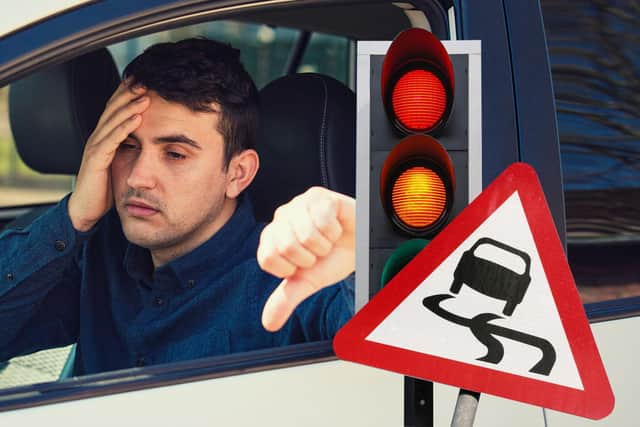The top 10 reasons learners fail the driving test
and live on Freeview channel 276
As thousands of learner drivers get back behind the wheel in an effort to secure their driving licence, data has revealed the most common reasons for learners failing the driving test.
Practical driving test pass rates in Britain remain stubbornly below 50 per cent - with just 45.9 per cent of learners passing between April 2019 and March 2020.
Advertisement
Advertisement
With 1.6 million people sitting the practical test over that period, that’s a lot of mistakes but data from the Driver and Vehicle Standards Agency (DVSA) reveals that the same errors catch learners out time and time again.


Now it has issued a list of the 10 most common reasons for failure:
1. Not making effective observations at junctions
This category covers a whole host of errors relating to how you approach and use junctions safely. Among the most common are not looking at all, or checking for other vehicles too late in your manoeuvre. Other issues include failing to judge the speed of an approaching vehicle or entering a roundabout when a vehicle is already approaching from the right. And worryingly, drivers failing to realise they are approaching a crossroads and crossing without making any observations is also singled out.
2. Not using mirrors correctly when changing direction


“Mirror, signal, manoeuvre” - it’s drilled into every learner right from the first lesson but, still, failing to use mirrors properly is the second most common mistake driving test candidates make. Making full use of your mirrors is vital to passing the test and issues such as failing to check before pulling into another lane, or not checking mirrors on a roundabout will not go down well with the examiner.
3. Not having proper control of the steering
Advertisement
Advertisement
According to DVSA guidance: “You must be able to steer the car as smoothly as possible. You must steer at the appropriate time, as steering too early or late can cause the car to hit the kerb or swing out towards another road user.”
However, its data highlights that a major problem remains learners repeatedly not steering enough or steering too late for a corner, junction or to pass parked cars, as is drivers hitting the left-hand kerb.


4. Incorrect positioning when turning right at junctions
Quite a specific issue but clearly still a common one. This failure category covers drivers being in the wrong lane at roundabouts, positioning their car poorly when stopped at junctions, and causing a traffic obstruction when waiting to turn right onto a minor road.
5. Not moving off safely
Throughout the test you will have to start from a complete stop on several occassions. Each time the examiner will assess your ability to move off whether it’s from the side of the road, on a slope or hill, from behind a parked vehicle, or from an emergency stop. As well as the technical aspect of pulling away smoothly, examiners are checking that you make the correct observations, including blind spot checks, and don’t pull away in a manner that causes another driver to take evasive action.
6. Not responding appropriately to traffic lights
Advertisement
Advertisement
Despite being as clear a signal as you can imagine, traffic lights still catch out plenty of learners. Common problems include learners not stopping at a red light or stopping in the section of a junction dedicated to cyclists. Green lights also seem tricky, with some drivers penalised for moving when it’s not safe to do so and others for failing to move off when it is safe.
7. Poor positioning on the road during normal driving
On a driving test you should always position the car correctly for your intended route, in the middle of marked lanes and should only change lanes when necessary. However, some candidates struggle with this, repeatedly sitting too close to either the kerb or the oncoming traffic, ignoring the normal road position on roundabouts or unnecessarily driving in the right-hand lane of a dual carriageway.
8. Not responding correctly to traffic signs
Another topic that’s covered at length in lessons and the theory test is how to recognise and obey traffic signs. Still, the DVSA data shows that some learners get caught out by things such as keep left signs, bus lane warnings, and even stop signs and speed limits.
9. Not having control of the vehicle when moving off
Nerves can get the better of any learner and one of the most obvious signs of this is stalling the car. One or two stalls won’t mean an automatic fail but repeatedly stalling, either in the same moving off attempt or repeatedly throughout the test could lead to a fail mark. Other issues in this category include rolling back on a hill start or trying to move off without selecting a gear, causing the car to roll back.
10. Not keeping control of the vehicle during reverse parking
Advertisement
Advertisement
The last in the top 10 reasons for failure can apply whether you’re parallel parking or reversing into a bay. In either case, ending up on the pavement or outside the allotted bay will be counted as a fault, as will losing control of the car or taking too many attempts to reposition the car.
Peter Brabin, head of training at www.billplant.co.uk, commented: “It’s really interesting to have this data broken down by the DVSA, highlighting exactly what UK learner drivers are most commonly struggling with when on their driving tests. What’s somewhat surprising is that a lot of the most common test failures are some of the very first things you’re taught when you get behind the wheel, but that clearly just goes to show that maintaining a regular pattern of lessons is important to keep up the fundamentals, and that nerves can play a large part in the test experience which causes silly mistakes that you wouldn't expect.”